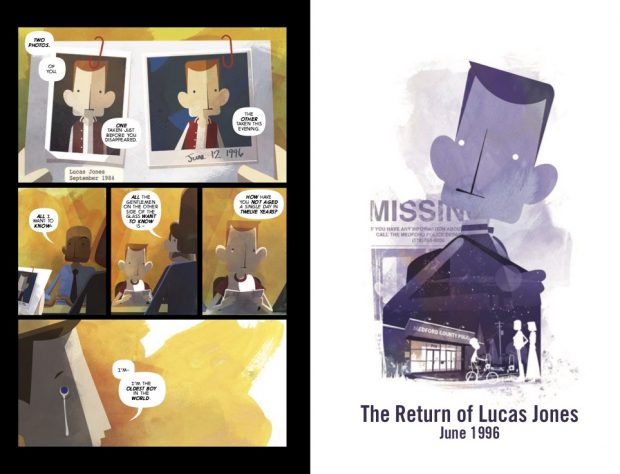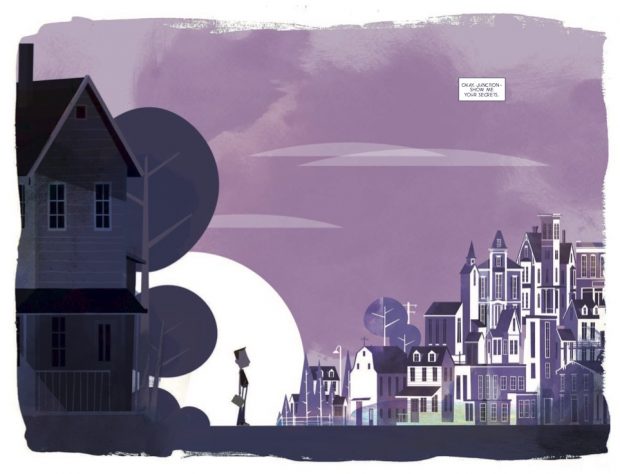“Even the strangest of places need some sort of framework” Norm Konyu discusses the dreamlike world of The Junction
Norm Konyu’s The Junction has firmly found itself at the top of our favourite reads of 2020 so far, and so with the Kickstater for this wonderful new book coming soon, we caught up with Norm to find out more about the inspiration for the book and also some of the hidden meaning going on within the world of Kirby Junction!
 The Junction starts as a missing persons story about a boy coming back to his home after 11 years (which feels like it’s from a tabloid), and then evolves into something much more interesting and through provoking. Can you tell us a bit about where the initial idea for the story came from and how it has evolved over time?
The Junction starts as a missing persons story about a boy coming back to his home after 11 years (which feels like it’s from a tabloid), and then evolves into something much more interesting and through provoking. Can you tell us a bit about where the initial idea for the story came from and how it has evolved over time?
Norm Konyu: You know, I can’t really pin down when the story became what it is. I do know that some of the sequences came from dreams, specifically one where I was trying to get out of an autumnal forest but the trees wouldn’t let me. The story kept altering even after I was well into the artwork stage. Not very professional, or the best use of my time, but I managed to flounder my way to a cohesive story in the end.
The book feels very carefully crafted and like it is governed by a strong sense of rules for the world, was it important for you to create a logic to the world even though strange things are going on within it?
NK: Absolutely. Even the strangest of places need some sort of framework. The strangeness needs some form of restriction. Hell, I need restrictions to work within. There are layers of the Junction I had in mind that never made the final cut. There was no need for them, but they were there in my head nevertheless.
The world of Kirby Junction feels like a slice of classic Small Town America, reminding us of everything from It’s A Wonderful Life to the Truman Show and even Tim Burton and David Lynch’s suburban worlds, is the town based on your own hometown? Or was it intended to be an idealised version?
NK: I grew up in Canada, in a very small town in Southern Ontario. Maybe the word town is too grand a term. Cows outnumbered residents two to one. I was bussed in to school in an actual small town, a place called Ancaster, maybe 12000 people. It had a bit of a High Street/Main Street, a couple of supermarkets and at least one of those big old water towers. There are dozens of these sorts of towns across Ontario, little islands in farmland, but many of them don’t really exist in the same shape or form anymore. Ancaster must be 3 times the size now, and its borders are beginning to meet the borders of the next town. It has a Wal-Mart. I think the water towers are gone. I feel a lot of these places have lost their individuality in the process, and I think that’s what I was harking back to with Kirby Junction – a town of the past viewed through the distorting lens of nostalgia. I’m probably ‘mis-remembering’ Ancaster in the same way.

The story has a real emotional heart to it and deals with ideas of grief and loss? Who do you think the book is aimed at? Is it an all ages story or something else? And was it important for the book to have this quite sophisticated emotional story at the heart of it?
NK: I’ve discussed the age range with a few people. There’s none of the usual age restrictors in it: sex, swearing, or gore, but it does have some ‘grown-up’ themes, the ones you mention, of grief and loss. Definitely fine for any 12 year old, but I suppose for those of a younger age, it depends on their maturity. Maybe I’m not giving under 12s enough credit. And the emotional story is certainly important. It’s important to any story, whether the emotion is grief, fear, love, or anger. Emotions drive stories.
It feels like a very complete story, how long have you been working on it for?
NK: A very long time! I recently found my first notes on this. Put it this way, they go back to the year that London hosted the Olympics. I haven’t worked on it constantly during those years… It sat around for quite some time (years), I spent time exploring personal style, and even more recently, when it was ‘finished’, I put it aside for a few months so I could look at it again with fresh eyes.

This is the first time we’ve seen your work, but it looks very polished and you have a really unique sense of character design that is more like a kids book than a traditional comic? What’s your background in? Am I right in thinking you’re in animation?
NK: Yes, that’s right. By day an animator, by night a graphic novelist. Bit like Bruce Wayne and Batman. I’ve been a part of the London animation industry for a long long time. During those years, I pretty well lost my personal style, always working in somebody else’s. I had to physically sit down over the course of several months to rediscover it before I could create anything with it. I recently wrote a post about just that for BleedingCool.com
What artists and story tellers inspire you? And inspired The Junction?
NK: Ray Bradbury. He wrote the most wonderful novels and short stories, full of mystery, threat, and nostalgia. Particularly ‘Something Wicked This Way Comes‘. Now, please don’t think I’m comparing The Junction to any of the great man’s work, but I think it was a definite influence.

• You are launching it on Kickstarter, why did you choose that platform rather than getting a publisher? (Or have you tried that already!)
NK: I’m a masochist? There wasn’t a direct path to the KIckstarter decision. I had pretty well finished the book before thinking about how I was going to publish it. I’d doubted I’d actually get it finished in the first place, so I was taking it one step at a time. I considered publishers, but sort of talked my way out of it, feeling that The Junction wasn’t really suited to this one or the other, perhaps wrongly. And then I went to Thought Bubble last year and saw the sheer range of self published authors and artists, and the decision was made.
Will you be heading out to any conventions with it this year? Thought Bubble surely?!
NK: Hopefully yes. My only confirmed Con at this point is Macc-Pow! in June. I’ve applied for Thought Bubble, of course, considering its influence on my choice of publishing. I’ve also put in an application for ELCAF. So I’m waiting on those, and waiting for other application processes to open up.

And finally If you could reveal one secret or key fact about The Junction, which people should look out for (but which doesn’t spoil the story) what would that be?
NK: The town is named Kirby Junction for two reasons. The first is that my favourite childhood comics were from the mind and pencil of the brilliant Jack Kirby. The second is a bit more subtle, but if people look carefully, they just may see the reason…
The Junction is coming to Kickstarter very soon (check out the pre-launch page here) and you can find out more about The Junction at junctiongraphicnovel.com or follow it on twitter @JunctionNovel



July 15, 2025 @ 12:53 am
I don’t think the title of your article matches the content lol. Just kidding, mainly because I had some doubts after reading the article.
October 9, 2025 @ 4:37 am
Hi there to all, for the reason that I am genuinely keen of reading this website’s post to be updated on a regular basis. It carries pleasant stuff. Stay with bbc bbc persian — regional coverage for Iran and Afghanistan. live bulletins and interviews. analysis programs, live updates. reliable HD stream on any device.
December 21, 2025 @ 8:15 am
Wunderwins bietet eine Vielzahl an Zahlungsmethoden an, die jedem Geschmack entsprechen sollten. Als langjähriger Spieler kann ich sagen, dass Wunderwins wirklich eine spannende
Plattform ist. Insgesamt bietet Wunderwins eine großartige Mischung
aus klassischen Spielautomaten und innovativen neuen Titeln. Wenn es um die Spiele bei Wunderwins geht, kann ich aus erster Hand sagen, dass die Auswahl beeindruckend
ist. Wichtig zu erwähnen ist auch das Loyalitätsprogramm,
das Wunderwins anbietet.
Was jedoch fehlt, sind klassische Reload-Boni mit niedriger Mindesteinzahlung sowie ein Wunderwins Bonus ohne
Einzahlung. Das Bonusangebot von Wunderwins Casino bietet viel Abwechslung und richtet
sich sowohl an Neukunden als auch an treue Spieler.
Die Freispiele aus dem Willkommenspaket werden in Paketen zu
je 20 Spins pro Tag über 5 Tage gutgeschrieben – insgesamt erhältst du so 100 Freispiele
pro Bonusstufe. Für deine Anmeldung und deine ersten 3 Casino Einzahlungen bekommst
du nämlich gesamt bis zu 1.650€ Bonus + 300
Freispiele.
Und das ist noch nicht alles – Stammspieler können sich auf wöchentliche Reloads von 50% bis zu 200 €, tägliche Freispiele und ein 5% Cashback-Angebot
jeden Montag freuen. Mit schnellen Auszahlungen, freundlicher Hilfe direkt zur Hand, perfekt abgestimmtem Mobile-Play und Bonusboosts,
um die Dinge frisch zu halten, ist dieses Casino das ultimative
Ziel für Nervenkitzel-Suchende und Gelegenheitsspieler gleichermaßen! Das
kann nützlich sein, falls Freunde aus anderen Ländern mitspielen möchten oder man selbst zweisprachig unterwegs ist.
Das macht es einfach angenehm und motivierend weiterzuspielen. Wie bei einer guten Partie Poker
kommt es darauf an, klug zu spielen und seine Chancen realistisch einzuschätzen.
References:
https://online-spielhallen.de/ihr-einstieg-ins-gluck-der-casino-of-gold-login/